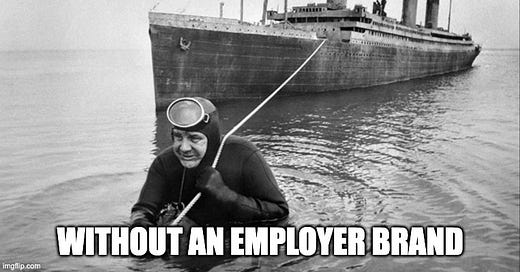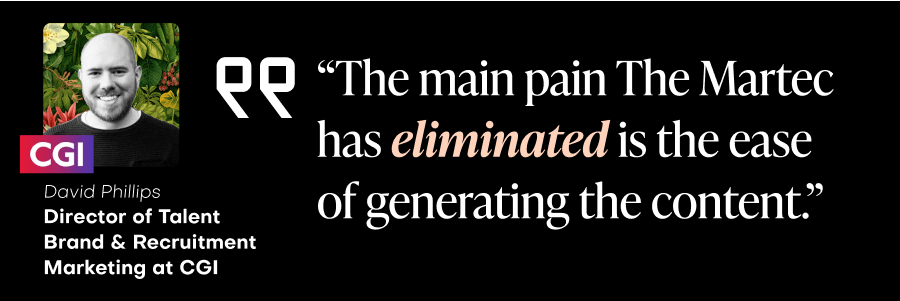“The Martec is at the heart of our content strategy...”
Hear it from David: “It actually looks great, it’s polished, it’s great content and it could have come from the agencies. I think it’s at the forefront of the recruitment and talent attraction industry. It’s what we want our AI-platforms to deliver: it’s time-saving, cost-saving, and the quality stays high.”
Learn why talent leaders like David have turned to the power of their PEOPLE with The Martec’s People-first, AI-accelerated employee content (both video+written) and advocacy platform.
[sponsored]
A lot of companies have gotten the message that they need an employer brand. So they got what they thought was an employer brand.
Maybe it was a listing of some values handed down from leadership.
Maybe it was a tagline that was simple and digestible enough to be splashed pretty much anywhere.
Maybe it was something an agency or consultant thought they could most easily “sell” to the company.
Either way, not all employer brands are created equal. In order of increasing value to the company, here are the kinds of employer brands I’ve seen in the world:
Least useful - No centralized employer brand direction
In this situation, recruiters aren’t given much guidance on what messages to share beyond the things a hiring manager might say about the role. There nothing on the career site that might back a recruiter’s claim up, it’s just every recruiter for her or himself trying to get someone to listen. Effectively, this is a blank sheet of paper (and likely a leader who thinks, “we have jobs, so we make the rules” so they don’t bother trying to say anything useful).
At least its something - Centralized generic brand claim
In the land of the blind, the one-eyed man is king. When you don’t have anything to say (or you choose not to say anything), badges that say you are a fantastic place to work, or claims that you have a great culture (whatever that means) are better than saying nothing. If nothing else, they suggest that you care enough to say something, even when you don’t know what to say.
Better - Value-based claims
As companies grow, this is often the most common type of employer brand they embrace. The company takes its stated values (whether they were stated for this project or pulled out of a dusty deck is immaterial) and says, “this is our EVP!” But those values sound like a million other companies’ values. Best idea wins? Driven by Purpose? Passion for our customers? Act like an owner? Respect, integrity, and inclusion? Community impact? Be a team player? We care about our people? I bet some of those sound pretty familiar. A lot of companies pick a few that make them feel good, slap them on their career site and call it a day. But when every company is sharing the same dozen claims, how exactly does that help a candidate chose one company over another?
These often come in the packaging of an EVP: Make each value a pillar, and you think you’ve got a real EVP instead of just a bunch of nice things to say as a way to describe you rather than differentiating you.
Stronger still - Credible values
Don’t get me wrong. There’s nothing wrong with using your values as the foundation of your employer brand. If those values actually drive your decision making and behaviors, they are worth building on. But to make them useful, you need to make them credible.
But if those values are actually driving decisions and behaviors, you should certainly have a million stories to tell where the values shaped the decisions and behaviors (the existence of all those stories is proof that your values are actually driving decisions and behaviors).
Saying that people there act like owners is easy. Telling ten stories where front-line and/or newer staff were able to stop the production line because they found a defect or bent over backwards to solve a customer problem is making that claim more believable.
If you can’t dive deep into brand differentiation (and I completely understand how corporate politics will push you away from something differentiating), the battle you need to win is that of credibility. Don’t just say something, prove it over and over again from as many vantage points as possible.
Big step up - Differentiated claim
We’re now in rarified air. Not many companies bother to build an employer brand that shows the way(s) it is legitimately different than it’s immediate competitors. But this is the direction you should be aiming.
A differentiated claim says: What makes your company different? Is it your mission? Your day-to-day work experience? What you give employees who are successful? You don’t have to be different in every single way, but that model of thinking makes it a bit easier to find the thing that makes you different that a candidate would care to know.
I struggle to determine which is more useful: A listing of credible and proven values or a differentiated claim. And there really isn’t a way to definitively say that one attracts more of the people you want to hire than the other. But what I would say is that if you lean on proven values, you’ve reached your ceiling. Sure, you can keep proving those core values to more and more granular audiences, but you’ll be living in a world of diminishing returns.
If you start with a differentiated claim, you’re nowhere near your potential. Where the proven values are at their ceiling, a differentiated value is at it’s floor. And as soon as you start doing the work to prove that (or those) differentiated value, you’ll be putting a lot of distance between you and the competitor who just focuses on values.
Strongest - Credible differentiation
Does anyone doubt that for ten-plus years that Facebook was the place to move fast and break things? It wasn’t just a claim, it was a way of being, something you could see in every Facebook social media posting, every job posting, every testimonial, every news story (eventually to its detriment).
This is what credible and proven differentiation looks like: Offer something that no one else does, then live it in every conceivable way. Done well, it isn’t a claim, it’s obvious. It’s that idea of how you do anything is how you do everything: This kind of brand is something that anyone can see clearly in any aspect of what you do.
Hopefully that makes it clear that “having” an employer brand is useful, but all employer brands are not the same. Some are fig leaves and some are DNA. Consider where yours is and plan accordingly.
🔭 The only thing I would change in Kevin Wheeler’s piece is the title. “Why Recruiting Is Not Strategic” suggests that recruiting can’t be strategic. Rather, this article shows all the ways in which recruiting seems terrified to grab on to meaningful strategy »
🔭 How to think about Brand Expansion »
🔭 If your leaders aren’t modeling your values, you don’t have values. »
🔭 Should we let employees define their own jobs? »
🔭 Can AI help you create more brand difference? »
🔭 Recruiting goal setting »
🔭 AI-based persona generator… that doesn’t suck? Crazy, right? Rather than focus on useless demographics, it identifies triggers for actions and suggests content ideas. And it’s free (at the moment) »
🔭 Tips to make your employer branding content more SEO friendly »
👗 If Dolce, Skimms, Gucci, and Hermes can carve out the space to show how they are different from dozens of well-funded and well-known brands, why can’t your employer brand? Example of brand archetypes in fashion »
🏛️ All 2,400+ articles from this newsletter are in a searchable archive. Go get ‘em!
Yep. I have PROOF that it only takes 3 weeks to get an employer brand that makes every single one of your recruiters and your recruiting tactics more effective.
Don’t believe me? Let me send you one of two case studies I just wrapped up. Just reply to this email and I’ll send one over.
Please share this: EmployerBrand.ing
***This Newsletter Contains No ChatGPT***









